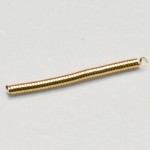What is French Wire?
 French wire can also be called ‘Gimp’. It is basically very narrow wire that has been coiled to form a sort of wire ‘tunnel’. It is available in gold or silver and is used to cover thread when you are attaching findings. This both protects the thread and gives a professional finish as you are left with what looks like a ring of wire, instead of visible thread around the ring on whichever finding you are using.
French wire can also be called ‘Gimp’. It is basically very narrow wire that has been coiled to form a sort of wire ‘tunnel’. It is available in gold or silver and is used to cover thread when you are attaching findings. This both protects the thread and gives a professional finish as you are left with what looks like a ring of wire, instead of visible thread around the ring on whichever finding you are using.
If you have made anything using bead-weaving techniques and are planning to attach a clasp using your thread, then it is a very good idea to use French wire. There is a full tutorial to download here for free so you can learn how to use this material, but happily, it’s very easy!
clasp using your thread, then it is a very good idea to use French wire. There is a full tutorial to download here for free so you can learn how to use this material, but happily, it’s very easy!
You can see in the photo above that the French wire looks like a narrow coil. It is available in different widths from some suppliers, but all are pretty narrow. You will certainly need a beading needle to use French Wire. If you try and push a more traditional sewing needle through the centre of the coil, you will find that it causes the wire to separate into an untidy mess. You should also take great care when you are cutting lengths of French Wire. You will probably need a length of no more than about an eighth of an inch (a few millimetres), but it is easy to uncoil the wire as you are cutting it. To avoid this, try using a pair of really sharp wire cutters and just take care not to stretch the French wire. It isn’t uncommon to have problems when you first start to work with this – French wire requires a delicate touch, but as with other beading techniques, just keep persevering as the effort is worthwhile in the end!
You can of course use a calotte as an alternative and you can find out more about using clasps here.











